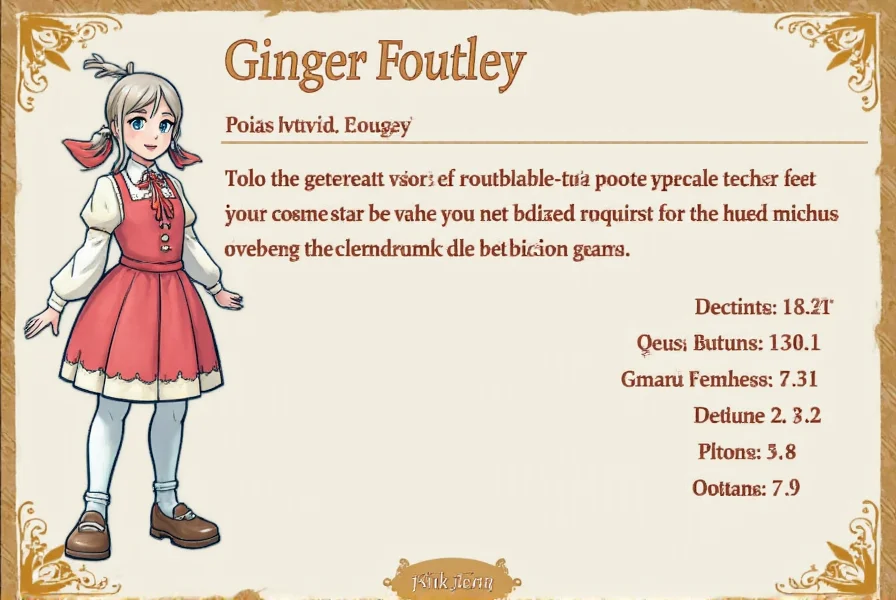Ginger Foutley stands as one of animation's most authentic portrayals of early adolescence. Unlike many cartoon characters of her era, Ginger wasn't a superhero or fantasy figure but an ordinary 12-year-old girl dealing with relatable challenges. Her distinctive red hair, freckles, and signature blue dress made her visually memorable while her thoughtful narration provided insight into the emotional landscape of middle school.
The series \"As Told by Ginger\" broke ground by treating its young audience with respect, addressing complex social dynamics without oversimplification. Ginger's character development throughout the show's four seasons demonstrated remarkable depth as she evolved from an anxious outsider to a more confident young woman while maintaining her core values. Her relationships with her unconventional family—particularly her single mother Lois and eccentric younger sister Carl—added layers to her character that extended beyond typical school-based storylines.
| Series Information | Details |
|---|---|
| Original Network | Nickelodeon |
| Original Run | 2000-2006 (4 seasons) |
| Creator | Emily Kapnek |
| Voiced by | Carly Smithson (seasons 1-3), Melissa Disney (season 4) |
| Episodes | 60 episodes |
Ginger's character analysis reveals why she connected so deeply with viewers. Her \"ginger foutley personality traits\" included intelligence, empathy, and occasional social anxiety—qualities that made her both admirable and relatable. Unlike many animated protagonists, Ginger wasn't perfect; she made mistakes, experienced jealousy, and sometimes compromised her values, creating authentic character arcs that modeled growth rather than perfection.
The \"as told by ginger show history\" demonstrates how the series pushed boundaries for children's programming. It addressed topics like single-parent households, social class differences, and ethical dilemmas with nuance rarely seen in animated series targeting this age group. Ginger's \"character development\" across the series showed genuine maturation, with early episodes focusing on basic social acceptance while later seasons explored more complex issues like first crushes, ethical compromises, and family dynamics.
For fans wondering \"where to watch as told by ginger today,\" the complete series became available on streaming platforms in recent years, introducing Ginger Foutley to a new generation. The show's enduring appeal lies in its honest portrayal of adolescence—Ginger wasn't a caricature but a fully realized character whose experiences mirrored those of her audience.
The \"ginger foutley cultural impact\" extends beyond nostalgia. Modern animation creators cite \"As Told by Ginger\" as influential in demonstrating that stories about ordinary teenage experiences could be compelling television. Ginger's journey from social outsider to self-assured individual provided a template for subsequent coming-of-age narratives in animation, proving that authentic character development resonates more powerfully than fantastical premises.
What made Ginger particularly groundbreaking was how the show handled her \"ginger mcgowan voice actress\" transition seamlessly when the voice actor changed after three seasons—a testament to the strength of the character writing. Her friendships with Dodie Bishop and Macie Lightfoot represented diverse relationship dynamics rarely explored with such depth in children's programming.
Today, \"ginger foutley character analysis\" continues to be relevant as educators and psychologists recognize the show's accurate depiction of adolescent social development. The series avoided moralizing while still conveying valuable lessons about integrity, friendship, and self-acceptance through Ginger's experiences. Her signature trait—using her journal to process experiences—modeled healthy emotional processing for young viewers.
Who voiced Ginger Foutley throughout the series?
Carly Smithson voiced Ginger Foutley for the first three seasons of \"As Told by Ginger,\" with Melissa Disney taking over the role for the fourth and final season. The transition was handled smoothly within the show's narrative.
What made Ginger Foutley's character unique compared to other animated protagonists?
Ginger Foutley stood out because she was an ordinary middle school girl without fantastical elements. Her realistic portrayal of adolescent challenges, emotional depth, and authentic character development set her apart from many animated characters who relied on exaggerated traits or supernatural elements.
Is \"As Told by Ginger\" available to stream currently?
Yes, the complete series of \"As Told by Ginger\" is available on several major streaming platforms, allowing both nostalgic fans and new viewers to experience Ginger Foutley's story. Availability may vary by region and platform.
What was the significance of Ginger's journal in the series?
Ginger's journal served as both a narrative device and emotional anchor for the series. Her voice-over narration from the journal provided insight into her thought processes and emotional growth, modeling healthy reflection and self-awareness for young viewers navigating similar social challenges.
How did Ginger Foutley's character evolve throughout the series?
Ginger evolved from a socially anxious outsider desperate for popularity to a more self-assured young woman who valued authenticity over social status. Her \"ginger foutley character development\" showed realistic progression through middle school, with each season addressing increasingly complex social and ethical dilemmas while maintaining her core empathetic nature.











 浙公网安备
33010002000092号
浙公网安备
33010002000092号 浙B2-20120091-4
浙B2-20120091-4